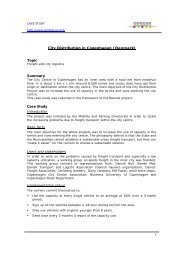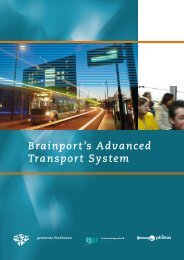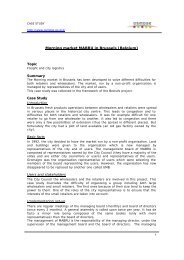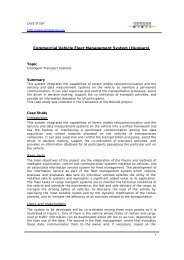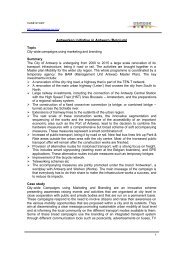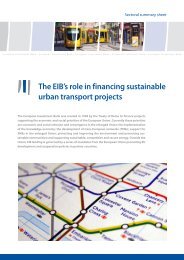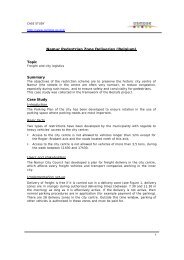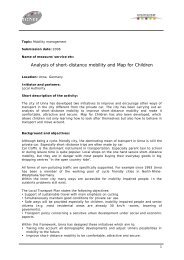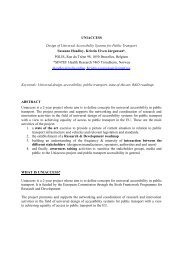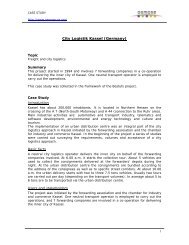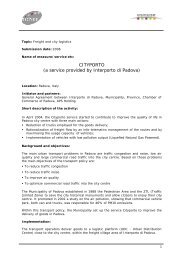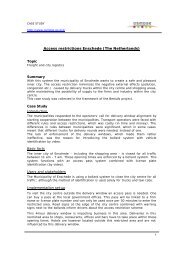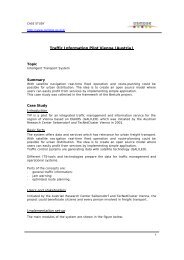Successful transport decision-making - Osmose
Successful transport decision-making - Osmose
Successful transport decision-making - Osmose
Create successful ePaper yourself
Turn your PDF publications into a flip-book with our unique Google optimized e-Paper software.
T2: Establishing the project management team<br />
Vol 1 - Table of Contents <br />
Next<br />
Who are the staff involved in the<br />
<strong>transport</strong> management team?<br />
Staff are an integral part of any project. The process of<br />
managing people within a project is one of the most important<br />
concepts of project management.<br />
The delivery of successful project management and<br />
engagement activities requires a high level of skill on the part<br />
of all people involved in the process. Good skills influence the<br />
project outcomes at many levels. For <strong>transport</strong> projects there<br />
are four key groups that play an important part in delivering<br />
quality outcomes. These groups have different roles and<br />
responsibilities in the project process:<br />
Project manager <br />
Project team <br />
External consultant <br />
Project champion <br />
Aims<br />
The main roles of the people involved in a <strong>transport</strong> project are:<br />
<br />
<br />
<br />
<br />
<br />
<br />
<br />
Identifying, tracking, managing and resolving project<br />
issues;<br />
Proactively disseminating project information to all<br />
stakeholders;<br />
Identifying, managing and mitigating project risk;<br />
Ensuring that the solution is of acceptable quality;<br />
Proactively managing the scope of the works to ensure that<br />
only what was agreed to is delivered, unless changes are<br />
approved;<br />
Monitoring and collecting information to give a sense of<br />
how the project is progressing and whether the<br />
deliverables are acceptable; and<br />
Managing the overall work plan, to ensure that work is<br />
assigned and completed on time and within budget.<br />
Useful hints<br />
Power struggles and lack of initiative are common<br />
problems; try to avoid this by creating a project team that<br />
works together, towards achieving common goals;<br />
Symptoms of an ineffective team include cautious or<br />
guarded communication, lack of agreement, use of<br />
personal criticism, malfunctioning meetings, unclear goals<br />
and low commitment;<br />
A productive team is characterised by common<br />
commitment, specific performance goals, the right size and<br />
right mix of people, a common approach and mutual<br />
accountability; and<br />
Approaches to building effective teams include careful<br />
selection, training, creating a sense of purpose, open<br />
communication and special team building techniques.<br />
42<br />
In practice<br />
Ile de France, France<br />
An Urban Transport Plan for the Ile-de-France region was signed in<br />
December 2000 after several months of preparation. It includes<br />
measures to decrease car traffic, encourage the use of public<br />
<strong>transport</strong>, minimise the impact of freight <strong>transport</strong> and organise<br />
parking facilities/policies. A project manager, called the Committee<br />
Manager, was appointed to organise and facilitate steering and<br />
technical committee meetings which were used to discuss local<br />
and/or technical issues.<br />
Madrid, Spain<br />
A major consideration in the preparation of the MetroSur bus<br />
network redesign process in Madrid was the involvement and<br />
engagement with stakeholders. However this involved<br />
considerable time and resource implications and caused obstacles<br />
to the project management process. To overcome these obstacles<br />
an external contractor was commissioned to conduct the<br />
engagement work. The external contractor was particularly useful<br />
as they were able to contribute additional time and skills to those of<br />
the project team.<br />
Graz, Austria<br />
The city-wide 30/50 kph speed limit in Graz was an unprecedented<br />
measure which raised legal and technical issues that were exploited<br />
by a strong political opposition. Problems, however, were solved by<br />
well-organised project management. The project group consisted of<br />
key <strong>decision</strong>-makers and experts from relevant subjects such as<br />
law, city planning, road construction, <strong>transport</strong>, and marketing. All<br />
were carefully chosen and motivated supporters. They established<br />
a discussion circle with regular meetings where they anticipated all<br />
foreseeable problems and prepared a solution in time. The factors<br />
of success were:<br />
<br />
<br />
The direct link of the management to the political level. The key<br />
<strong>decision</strong>-maker and project manager, acted as a project<br />
champion.<br />
The smoothing of the bureaucratic process. The project<br />
champion became head of the key departments of the city<br />
council. This ensured that managerial <strong>decision</strong>s could be carried<br />
out effectively.<br />
Examples of marketing campaign for Graz.



